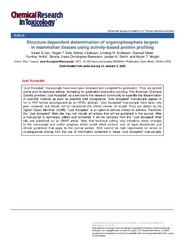Structure dependent determination of organophosphate targets in mammalian tissues using activity-based protein profiling
Permanent lenke
https://hdl.handle.net/10037/17719Dato
2019-12-24Type
Journal articleTidsskriftartikkel
Peer reviewed
Forfatter
Linn, Vivian S; Volk, Regan F; DeLeon, Adrian J; Anderson, Lindsey N; Purvine, Samuel Owen; Shukla, Anil K; Bernstein, Hans Christopher; Smith, Jordan N; Wright, Aaron TSammendrag
Acute and chronic exposure to organophosphates (OPs), including agricultural pesticides, industrial chemicals, and chemical warfare agents, remain a significant worldwide health risk. The mechanisms by which OPs alter development and cognition in exposed individuals remain poorly understood, in part due to the large number of structurally diverse OPs and the wide range of affected proteins and signaling pathways. To investigate the influence of structure on OP targets in mammalian systems, we have developed a series of probes for activity-based protein profiling (ABPP) featuring two distinct reactive groups that mimic OP chemical reactivity. FOP features a fluorophosphonate moiety, and PODA and CODA utilize a dialkynyl phosphate ester; both reactive group types target serine hydrolase activity. As the oxon represents the highly reactive and toxic functional group of many OPs, the new probes described herein enhance our understanding of tissue-specific reactivity of OPs. Chemoproteomic analysis of mouse tissues treated with the probes revealed divergent protein profiles, demonstrating the influence of probe structure on protein targeting. These targets also vary in sensitivity towards different OPs. The simultaneous use of multiple probes in ABPP experiments may therefore offer more comprehensive coverage of OP targets; FOP consistently labeled more targets in both brain and liver than PODA or CODA, suggesting the dialkyne warhead is more selective for enzymes in major signaling pathways than the more reactive fluorophosphonate warhead. Additionally, the probes can be used to assess reactivation of OP-inhibited enzymes by N-oximes and may serve as diagnostic tools for screening of therapeutic candidates in a panel of protein targets. These applications will help clarify the short- and long-term effects of OP toxicity beyond acetylcholinesterase inhibition, investigate potential points of convergence for broad spectrum therapeutic development, and support future efforts to screen candidate molecules for efficacy in various model systems.
Forlag
American Chemical Society (ACS)Sitering
Linn, V., Volk, R.F., DeLeon, Anderson, L.N., Purvine, S.O., Shukla, A.K., Bernstein, H.C., Smith, J.N., Wright, A.T. (2019) Structure dependent determination of organophosphate targets in mammalian tissues using activity-based protein profiling. Chemical Research in Toxicology, 2019Metadata
Vis full innførselSamlinger
Copyright © American Chemical Society


 English
English norsk
norsk